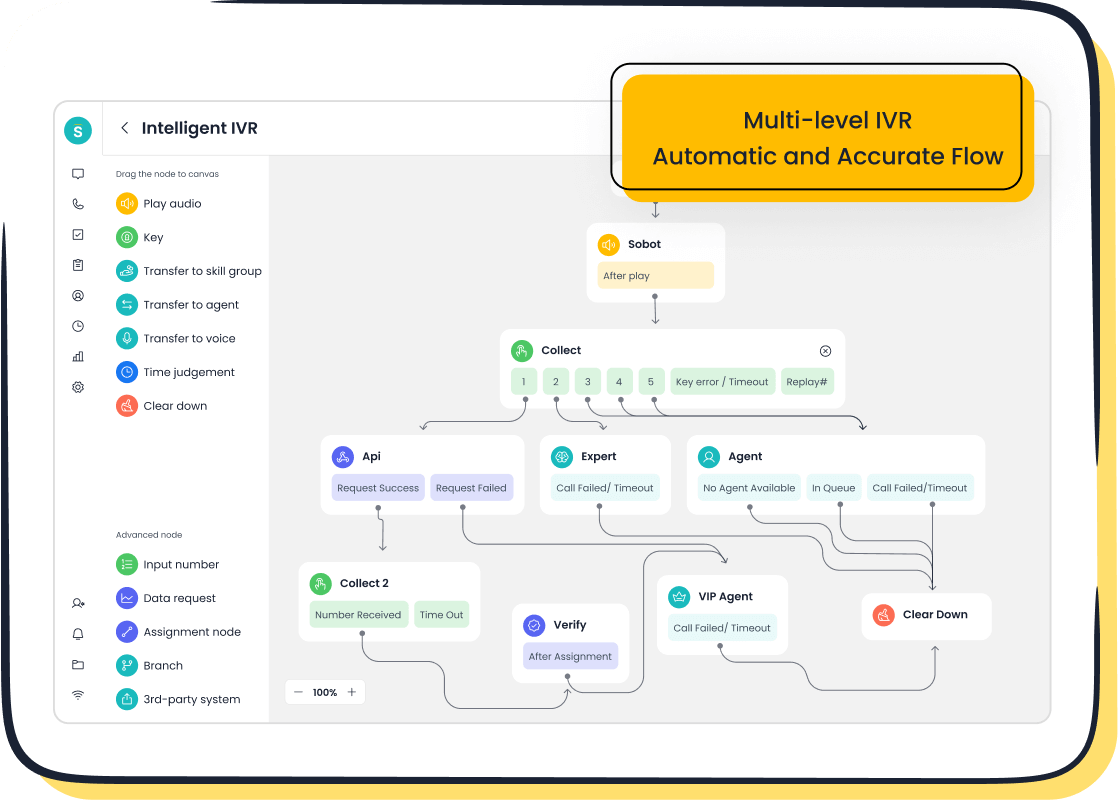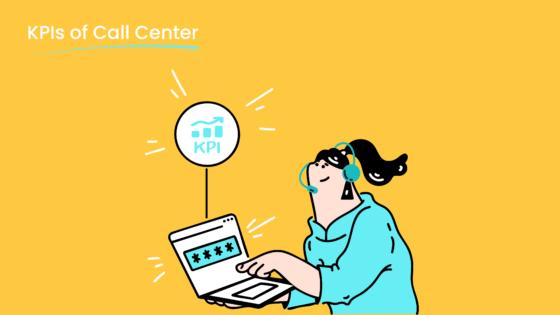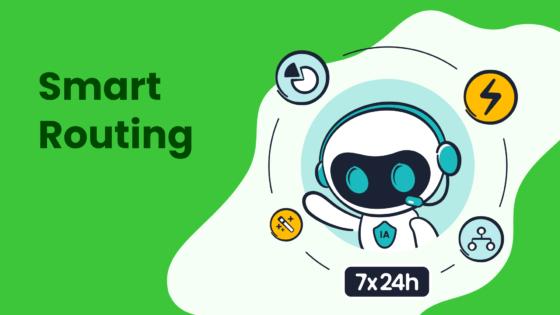Average Hold Time (AHT) Benchmarks Across Industries Explained

Average Hold Time (AHT) measures the duration customers spend waiting on hold during a call. It serves as a critical metric for assessing customer experience and operational efficiency in contact centers. Long hold times often frustrate customers, while shorter waits can enhance satisfaction and loyalty.
In 2025, AHT benchmarks vary significantly across industries. Retail contact centers aim for 1-2 minutes, while banking averages 2-3 minutes. Airlines face higher thresholds, ranging from 3-5 minutes, and telecommunications providers typically maintain 2-4 minutes. As a general rule, keeping hold times under two minutes is considered ideal for most sectors.

Sobot’s advanced Voice/Call Center solutions help businesses achieve these benchmarks by leveraging intelligent IVR systems, real-time analytics, and AI-powered voicebots. These tools streamline workflows, reduce wait times, and improve overall service quality.
Why Average Hold Time (AHT) Benchmarks Matter
Enhancing Customer Experience
The impact of long hold times on customer satisfaction
Long hold times can significantly harm customer experience. Customers often feel frustrated when forced to wait, leading to dissatisfaction and potential loss of loyalty. Studies show that longer hold times increase call abandonment rates, which average 5.91% across industries. This directly impacts a company’s ability to resolve customer issues efficiently. Additionally, 78% of consumers have reduced their planned purchases due to poor service experiences, including extended hold times. These statistics highlight the importance of minimizing delays to maintain a positive brand perception and retain customers.
How short hold times foster customer loyalty
Shorter hold times contribute to higher satisfaction levels and foster loyalty. Efficient service delivery reassures customers that their time is valued. For example, 58% of American consumers are willing to pay more for better customer experiences, which often include reduced waiting periods. Companies that consistently meet or exceed AHT benchmarks enhance their reputation for quality service. This not only improves customer retention but also strengthens long-term relationships, driving repeat business.
Driving Operational Efficiency
Reducing costs through optimized handle time
Optimizing average handle time directly impacts operational efficiency. Shorter hold times allow contact centers to handle more customer requests within a shift, reducing overall costs. By streamlining workflows and leveraging tools like Sobot’s Voice/Call Center, businesses can allocate resources more effectively. Features such as intelligent IVR and AI-powered voicebots help reduce unnecessary delays, ensuring that agents focus on resolving issues promptly.
Balancing efficiency with service quality
While reducing handle time is essential, maintaining service quality is equally important. Contact centers must strike a balance between speed and effectiveness. Real-time monitoring and analytics, like those offered by Sobot, enable managers to identify bottlenecks and adjust strategies. This ensures that customers receive timely assistance without compromising the quality of interactions.
The Role of Contact Centers in Managing AHT
How Sobot's Voice/Call Center optimizes AHT
Sobot’s Voice/Call Center provides advanced tools to help businesses meet AHT benchmarks. Intelligent IVR systems streamline call routing, ensuring customers reach the right agent quickly. AI-powered voicebots handle routine inquiries, freeing agents to focus on complex issues. These features reduce average hold time (AHT) while maintaining high service quality. With a 99.99% system uptime, Sobot ensures reliable operations for businesses across industries.
Real-time monitoring and analytics for better performance
Real-time analytics play a crucial role in managing AHT. Sobot’s platform offers comprehensive monitoring tools that track key performance indicators (KPIs) like hold times and resolution rates. Managers can use this data to identify trends, optimize workflows, and improve resource allocation. This proactive approach enhances both customer experience and operational efficiency, making it easier for businesses to achieve their benchmarking goals.
Average Hold Time (AHT) Benchmarks by Industry in 2025
Retail Industry
AHT benchmarks for e-commerce and physical stores

The retail industry often sets the standard for shorter average hold times. In 2025, e-commerce platforms aim for AHTs under 2 minutes, while physical stores typically target 1-2 minutes. These benchmarks reflect the fast-paced nature of retail, where customers expect quick resolutions. Shorter hold times not only improve customer experience but also enhance operational efficiency. Retailers often rely on advanced tools like Sobot’s Voice/Call Center to achieve these goals. Features such as intelligent IVR and real-time analytics streamline workflows, ensuring customers receive prompt assistance.
Examples of top-performing retail contact centers
Top-performing retail contact centers prioritize efficiency and customer satisfaction. For instance, companies with AHTs below 2 minutes often report higher first call resolution (FCR) rates, averaging 78%. These centers also achieve customer satisfaction (CSAT) scores exceeding 85%, as shown in recent call center statistics. By leveraging AI-powered voicebots and unified workspaces, retailers can handle high volumes of inquiries without compromising service quality.
Healthcare Industry
Challenges in healthcare affecting AHT
The healthcare industry faces unique challenges that impact AHT. Long hold times often result from complex phone trees and inefficient call routing. Agents may place callers on hold to manage high workloads, further increasing handle time. Optimizing these workflows is essential for improving AHT. Breaking down AHT into talk time, hold time, and wrap-up time helps healthcare providers identify bottlenecks. This approach ensures patients receive timely and accurate assistance.
Benchmarks for hospitals, clinics, and telehealth services

In 2025, healthcare contact centers report an average AHT of 6.6 minutes. Hospitals and clinics often struggle to meet this benchmark due to the complexity of patient inquiries. Telehealth services, however, leverage technology to reduce AHT, improving both efficiency and customer experience. Tools like Sobot’s Voice/Call Center enable healthcare providers to optimize call routing and monitor KPIs in real time, ensuring patients connect with the right specialists quickly.
Telecommunications Industry
Managing high call volumes and their impact on AHT
The telecommunications industry frequently deals with high call volumes, which can significantly affect AHT. Metrics such as average call duration and service levels play a crucial role in managing these challenges. Efficient contact centers use advanced tools to reduce hold times while maintaining service quality. For example, Sobot’s AI-powered voicebots handle routine inquiries, allowing agents to focus on complex issues. This approach minimizes delays and enhances customer satisfaction.
Benchmarks for mobile, internet, and cable providers

Telecommunications providers aim for AHTs between 2-4 minutes in 2025. Mobile and internet services often achieve lower AHTs due to streamlined workflows, while cable providers face slightly higher thresholds. Meeting these benchmarks requires a balance between speed and effectiveness. Real-time monitoring tools, like those offered by Sobot, help providers track KPIs and adjust strategies to meet industry benchmarks.
Financial Services Industry
AHT benchmarks for banks, insurance, and fintech companies
The financial services industry often deals with complex customer inquiries, which can extend average handle time. On average, financial institutions report an AHT of approximately six minutes. Within this, the average hold time for banking services ranges from 2 to 3 minutes. These benchmarks reflect the need for detailed interactions, such as verifying customer identities or explaining financial products.
Banks and insurance companies often rely on advanced tools to meet these benchmarks. For example, intelligent IVR systems streamline call routing, ensuring customers connect with the right department quickly. Fintech companies, known for their tech-driven approach, leverage AI-powered voicebots to handle routine queries. These solutions not only reduce hold times but also enhance customer experience by providing timely and accurate assistance.
Meeting customer expectations in financial services
Customer expectations in financial services are high. Clients demand quick resolutions without compromising service quality. Meeting these expectations requires a balance between efficiency and thoroughness. Contact centers in this industry often use real-time analytics to monitor KPIs like hold times and resolution rates.

Sobot’s Voice/Call Center offers features like smart call routing and AI-powered voicebots, which help financial institutions optimize workflows. These tools ensure agents focus on resolving complex issues while routine tasks are automated. By adopting such solutions, financial services providers can meet industry benchmarks and deliver superior customer experiences.
Other Key Industries
Benchmarks for travel and hospitality contact centers
The travel and hospitality industry faces unique challenges due to seasonal demand fluctuations. Average handle time benchmarks in this sector vary widely, influenced by factors like booking complexities and customer inquiries about cancellations. Efficient contact centers aim to keep AHT under five minutes during peak seasons.
Advanced tools like Sobot’s Voice/Call Center help businesses in this industry manage high call volumes. Features such as real-time monitoring and global number availability ensure seamless operations. These capabilities enable travel and hospitality providers to maintain service quality even during busy periods, enhancing customer satisfaction.
Benchmarks for utilities and energy providers
Utilities and energy providers often deal with technical issues and billing inquiries, which can extend handle time. Industry benchmarks for AHT in this sector typically range from 4 to 6 minutes. Efficient call centers use technology to streamline processes and reduce delays.

Sobot’s solutions, including intelligent IVR and unified workspaces, allow agents to access customer data quickly. This reduces hold times and ensures accurate responses. By leveraging such tools, utilities and energy providers can meet industry benchmarks while improving operational efficiency.
Factors Influencing AHT Variations
Technology and Automation
The role of AI and chatbots in reducing handle time
Advancements in AI and automation have transformed how contact centers manage average handle time. AI-powered chatbots handle routine inquiries, such as account balance checks or order tracking, reducing the need for human intervention. This automation allows agents to focus on complex issues, improving efficiency and customer experience. For example, implementing call center software that tracks average hold times in real time enables managers to address delays immediately. Additionally, automating repetitive tasks, such as after-call work, further reduces handle time, ensuring smoother operations.
Limitations of automation in complex customer queries
While automation excels at handling straightforward tasks, it often struggles with complex or emotionally sensitive issues. Customers seeking detailed explanations or personalized solutions may find automated responses inadequate. In such cases, agents must step in, which can increase handle time. Balancing automation with human expertise ensures that service quality remains high. Tools like Sobot’s Voice/Call Center integrate AI-powered voicebots with intelligent call routing, ensuring customers connect with the right agent when automation reaches its limits.
Customer Expectations
How expectations vary across industries
Customer expectations differ significantly across industries. In healthcare, 66% of patients expect hold times under two minutes, while 33% abandon calls if delays occur. In contrast, industries like telecommunications often face more lenient expectations due to the complexity of technical issues. Meeting these varying expectations requires tailored strategies. Contact centers must analyze performance data to align their operations with industry-specific benchmarks, ensuring customer satisfaction.
The influence of cultural and regional differences
Cultural and regional factors also shape customer expectations. For instance, customers in North America prioritize speed, while those in Asia may value detailed explanations over shorter calls. Contact centers must adapt their strategies to these preferences. Sobot’s global number availability and time zone support enable businesses to provide localized services, ensuring a consistent customer experience across regions.
Industry-Specific Challenges
Regulatory requirements and their impact on AHT
Regulations in industries like healthcare and financial services often require agents to verify customer identities or provide detailed disclosures. These steps, while necessary, can extend handle time. For example, banks must comply with Know Your Customer (KYC) regulations, which add layers of complexity to interactions. Contact centers can mitigate these delays by using tools like Sobot’s intelligent IVR, which streamlines verification processes without compromising compliance.
Seasonal demand fluctuations in certain industries
Seasonal spikes in demand, such as holiday shopping in retail or peak travel seasons, can strain contact centers. These fluctuations often lead to longer hold times and reduced service quality. Advanced solutions like Sobot’s real-time monitoring tools help businesses allocate resources effectively during high-demand periods. By analyzing call center statistics, managers can adjust staffing levels and workflows to maintain efficiency and meet industry benchmarks.
How to Use AHT Benchmarks to Improve Performance
Setting Realistic Goals
Aligning AHT targets with industry standards
Setting achievable Average Hold Time (AHT) goals begins with understanding industry benchmarks. For example, retail contact centers often aim for AHTs under two minutes, while healthcare providers may target six minutes due to the complexity of inquiries. Aligning goals with these standards ensures businesses remain competitive while meeting customer expectations. Contact centers can use tools like Sobot’s Voice/Call Center to monitor KPIs and adjust workflows, helping them stay within industry norms.
Customizing benchmarks for your business model
Every business has unique needs, making it essential to tailor AHT benchmarks to fit specific models. For instance, a financial services provider may prioritize thoroughness over speed, while an e-commerce platform might focus on rapid resolutions. Custom benchmarks allow businesses to balance efficiency and service quality. By analyzing performance data, companies can identify trends and set realistic targets that align with their operational goals.
Strategies for Reducing AHT
Training customer service teams effectively
Well-trained agents play a crucial role in reducing AHT. Effective training programs should focus on improving communication skills, product knowledge, and problem-solving abilities. Businesses can implement strategies such as:
- Streamlining call routing to connect customers with the right agents.
- Allocating additional resources during peak times.
- Offering self-service options for common inquiries.
- Monitoring call center analytics to identify areas for improvement.
- Investing in continuous skill development for agents.
- Collecting customer feedback to refine processes.
These steps not only reduce hold times but also enhance customer experience by ensuring agents handle calls efficiently.
Leveraging Sobot's Voice/Call Center for streamlined processes
Sobot’s Voice/Call Center offers advanced features to optimize AHT. Intelligent IVR systems route calls to the most suitable agents, while AI-powered voicebots handle routine inquiries. Real-time monitoring tools provide actionable insights, enabling managers to address delays promptly. These capabilities help businesses streamline operations, reduce costs, and improve service quality.
Monitoring and Adjusting AHT
Using analytics to track and improve performance
Real-time analytics are essential for tracking AHT and identifying bottlenecks. Monitoring KPIs like hold times and resolution rates allows businesses to make data-driven decisions. For example, during peak periods, organizations can dynamically adjust staffing levels or workflows to minimize delays. This proactive approach ensures consistent performance and enhances customer satisfaction.
Adapting to changes in customer behavior and industry trends
Customer expectations and industry trends evolve over time. Regularly analyzing call center analytics helps businesses stay ahead of these changes. For instance, a rise in self-service preferences may require expanding chatbot capabilities. Similarly, seasonal demand fluctuations might necessitate temporary adjustments in staffing. By leveraging tools like Sobot’s real-time reporting, businesses can adapt quickly, ensuring they meet both customer needs and industry benchmarks.
Average Hold Time (AHT) benchmarks play a vital role in shaping customer service and operational efficiency. Shorter hold times not only improve customer satisfaction but also enhance brand perception and loyalty. Businesses that monitor and optimize AHT can allocate resources effectively, reduce costs, and deliver superior service.
Key Insights:
- Shorter AHT correlates with higher customer satisfaction and retention.
- Monitoring AHT identifies opportunities to improve service delivery.
Sobot’s Voice/Call Center offers advanced tools like intelligent IVR and real-time analytics to help businesses achieve these benchmarks. By leveraging these solutions, companies can enhance customer satisfaction metrics and maintain a competitive edge in their industries.
FAQ
What is the ideal Average Hold Time (AHT) for most industries?
The ideal AHT varies by industry. Retail contact centers aim for 1-2 minutes, while healthcare averages 6.6 minutes. Telecommunications providers target 2-4 minutes. Businesses should align their AHT goals with industry benchmarks to maintain customer satisfaction and operational efficiency.
How does Sobot help businesses reduce Average Hold Time (AHT)?
Sobot’s Voice/Call Center optimizes AHT through intelligent IVR systems, AI-powered voicebots, and real-time analytics. These tools streamline call routing, automate routine inquiries, and provide actionable insights. Businesses using Sobot achieve faster resolutions and improved customer experiences.
Why do healthcare contact centers have higher AHT benchmarks?
Healthcare inquiries often involve complex issues, such as patient records or medical advice. These require longer interactions. Tools like Sobot’s Voice/Call Center help healthcare providers manage these complexities by improving call routing and monitoring performance metrics.
Can automation completely eliminate hold times?
Automation reduces hold times but cannot eliminate them entirely. AI-powered tools like Sobot’s voicebots handle routine tasks efficiently. However, complex or sensitive issues still require human intervention, ensuring service quality remains high.
How can businesses monitor and adjust their AHT effectively?
Real-time analytics provide valuable insights into AHT trends. Sobot’s Voice/Call Center offers monitoring tools that track key performance indicators. Managers can use this data to adjust workflows, allocate resources, and meet industry benchmarks.
See Also
Best Call Center Analytics Tools To Use In 2024
Enhancing Call Center Efficiency Through Effective Monitoring
Excelling At Live Chat Within The Retail Sector
Essential Practices For Effective Call Center Quality Management
Comprehensive Overview Of Call Center Quality Assurance Tools
